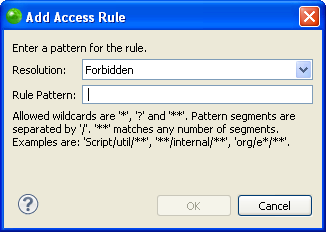Adding External Folders to PHP Libraries
This procedure describes how to add external folders to a user library. This allows you to compile a user library using folders from varying places on your computer. In order to add an external folder, you must have already created a user library. For more information see Adding a PHP Library.
If you are interested in using compressed files, click the Add ZIPs.... button and select a file instead of following the procedure below.
|
|
|
|
|
To add an external folder to your user library:
|
|
The folder will be added to the PHP library. The folders that are included in the user defined libraries allow you to control their access rules. The access rule default setting is "No restrictions." See Defining Access Rules below for more information. |
|
Defining Access Rules
This procedure describes how to define access rules. Access rules allow you to control where your libraries will be available. From here you can control what code completion options will be available in features such as Content Assist on a project level.
In order to define access rules you must have an external PHP folder added to your project. For more information Adding External Folders to PHP Libraries.
|
|
|
|
|
To define an access rule for your user defined library:
This will automatically apply the rule to any of the files that match the pattern. To apply changes click OK.
|
|
Your PHP Library now has an access rule defined in the hierarchal tree in the PHP Libraries Preferences page. You may edit a file's access rule at any time by repeating this procedure. |
|


